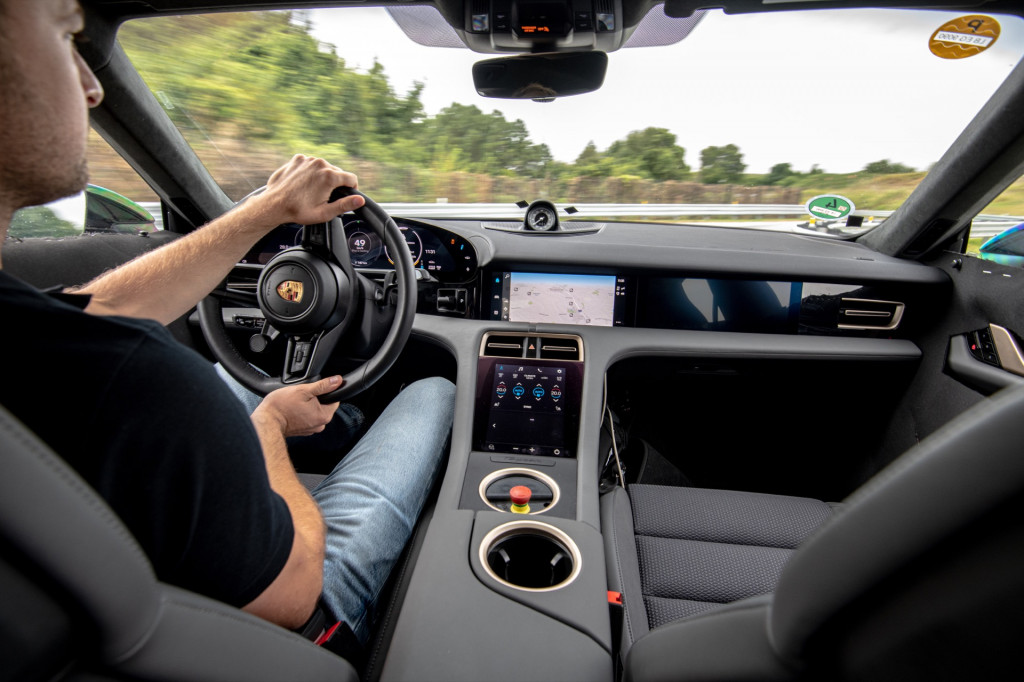Porsche doesn’t believe in one-pedal driving. And its electric vehicles—including the 2020 Porsche Taycan—aren’t going to have the feature.
“It is easier to control braking point and deceleration with one pedal, the brake pedal,” bluntly summed Ingo Albers, Porsche’s director overseeing chassis and some of the critical dynamic and stability aspects of the Taycan.
As Albers talked us through that particular point, at a technical backgrounder event, a few weeks ago, it sounded a bit like this wasn't the first time he'd fielded quizzical looks. Up until now Tesla and many other makers of electric vehicles have worked to establish the feature as linked to performance driving and efficiency in EVs—as a sort of “pro mode” for electric driving.
One-pedal driving is signaled by a very high rate of brake regeneration upon lift-off of the accelerator pedal. It gives drivers the ability to drive gently without needing to press the brake pedal—or perhaps saving it only for keeping the vehicle from rolling at a stop, or for abrupt maneuvers. It’s been a singular experience that’s unified the set of very different contemporary electric cars up until now.
Porsche was not convinced. And as we probed deeper, we noted that Porsche wasn’t simply saying here that it was trying to match the behavior of its gasoline vehicles. This is after all a company where engineering commands top-level decisions (if the Taycan's 800-volt system-power wizardry and super-fast DC fast charging weren't enough).

2020 Porsche Taycan preview
Cranking up the regeneration (or recuperation, as it tends to say) is not the solution for better efficiency or better performance, said the vice president for the 2020 Taycan product line, Stefan Weckbach. In studying both things earlier on in product development—including out on the track, where too much regen on lift can get in the way of lap times—Porsche decided that it was better to allow easy coasting, and to save the vast majority of brake regeneration for the brake pedal.
It’s different than the logic applied in other production EVs. Tesla vehicles offer their normal peak regeneration for a lift of the accelerator, and leave the brake pedal solely for modulating the brake pads. The Nissan Leaf goes another direction with its e-Pedal feature that will actually supplement friction brakes when you lift off the accelerator. Most other electric vehicles present some of their brake regen when you lift off the accelerator, then the rest as you press the brake pedal, blending the two together in what can be a tricky handoff at times.
Non-Tesla models with strong brake regen have included the BMW i3 and Jaguar I-Pace, as can a number of other affordable electric models like the Hyundai Kona Electric and Kia Niro EV. Porsche’s Audi cousin across the Volkswagen Group has decided to go somewhere in the middle with its regenerative braking, opting for several levels of softer regen, more on tap with the brake pedal, and then, in the Audi E-tron SUV, a clever system that only mechanically connects the friction brakes when you need them.
The Taycan won’t have levels of regen to toggle through, or the accompanying paddle-shifters or shift knobs. But it will give drivers a choice to toggle a light amount of lift-off regen on, with actual brake-off regeneration following four scenarios:
- Lift-off recuperation off, coasting
- Lift-off recuperation on
- Auto-recuperation with camera
- Max recuperation, used by all driver-assistance features

2020 Porsche Taycan preview
According to Porsche, 90 percent of all braking events are covered entirely (except for the last few inches, perhaps) through recuperation. Weckbach told Green Car Reports that involves using the front motor for up to the Taycan Turbo’s maximum front-axle forward power of 175 kw, for regenerative braking, while using the rear motor for the balance of up to 90 kw of recuperation.
Blending of the brake-pedal feel was an engineering challenge. Porsche isn’t letting down any of its reputation about being a high-end performance-car maker, and between white (standard) and yellow (carbon-ceramic) brakes it aimed for consistent behavior, independent of battery state and temperature. And it says that while the pads in the Taycan may last “hundreds of thousands of kilometers” before they’re worn, its customers should still change the pads after six years because the compound ages over time.
The Auto-recuperation mode could prove especially useful as it will give a much higher level of regen upon the lift of the accelerator to help match following speed and reduce the amount of dabbing back and forth for the brake pedal when in traffic.
If you’re not following traffic, Porsche’s Albers has a clear takeaway: “It is efficient to coast and keep kinetic energy in the vehicle.” And as Porsche knows from racing, smooth is fast.












